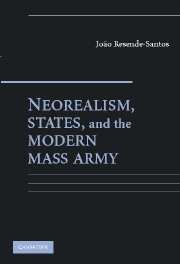Book contents
- Frontmatter
- Contents
- List of Tables and Figures
- Acknowledgments
- 1 Military Emulation in the International System
- 2 Theory of Military Emulation
- 3 Arms and States in Nineteenth-Century South America
- 4 Military Emulation in Chile, 1885–1914
- 5 Military Emulation in Argentina, 1895–1930
- 6 Military Emulation in Brazil, 1870–1930
- 7 Conclusion
- Index
5 - Military Emulation in Argentina, 1895–1930
Published online by Cambridge University Press: 23 November 2009
- Frontmatter
- Contents
- List of Tables and Figures
- Acknowledgments
- 1 Military Emulation in the International System
- 2 Theory of Military Emulation
- 3 Arms and States in Nineteenth-Century South America
- 4 Military Emulation in Chile, 1885–1914
- 5 Military Emulation in Argentina, 1895–1930
- 6 Military Emulation in Brazil, 1870–1930
- 7 Conclusion
- Index
Summary
“It is no longer possible to improvise armies as in the past,” warned Argentina's War Minister, Guillermo Villanueva, in 1896, as the country prepared to match the military developments under way in the region. Argentine journalist Ernesto Quesada was more insistent and denigrating, decrying in 1898 Argentina's military “negligence” in the face of “military imbalance” favoring the “Chilean hordes.” In the decade after the start of Chile's military emulation Argentina relied on its old army to face the growing power of its rival across the Andes. Yet it did so for other than financial reasons.
Argentina in the 1890s was entering the new century as the most developed and prosperous of the Latin American republics and one of the richest nations in the world. Between the time of effective national union in 1880 and the First World War, Argentina experienced one of the world's most rapid economic growth rates. Its average annual growth rate between 1870 and 1914 was an estimated 5 percent, fueled by a tremendous expansion in agricultural and livestock production, and a large influx of foreign capital and immigrant labor. Argentina's was an export-led economy, with its major strategic sectors controlled by foreign (mainly British) capital. During this same time period, Argentina also experienced enormous social and demographic changes, essentially turning from a Latin to a European country in the makeup of its population, society, and cultural habits.
- Type
- Chapter
- Information
- Neorealism, States, and the Modern Mass Army , pp. 185 - 239Publisher: Cambridge University PressPrint publication year: 2007



